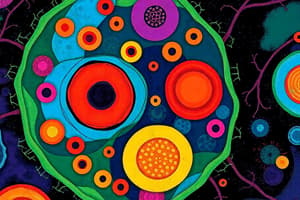Podcast
Questions and Answers
What is the primary function of the plasma membrane in a cell?
What is the primary function of the plasma membrane in a cell?
- To facilitate the movement of waste products out of the cell
- To act as a selective barrier, allowing nutrients to enter and waste products to leave (correct)
- To provide structural support for the cell
- To house the genetic information necessary for cell growth and reproduction
Which of the following organelles is responsible for energy transactions within the cell?
Which of the following organelles is responsible for energy transactions within the cell?
- Mitochondria (correct)
- Endoplasmic reticulum
- Chloroplasts
- Lysosomes
What is the primary role of the nucleus in a cell?
What is the primary role of the nucleus in a cell?
- To facilitate the movement of molecules within the cell
- To contain the genetic information necessary for cell growth and reproduction (correct)
- To break down unwanted materials within the cell
- To house the cytoplasm and organelles
Which organelle is responsible for the process of photosynthesis in plant cells?
Which organelle is responsible for the process of photosynthesis in plant cells?
What is the primary function of the cytoplasm in a cell?
What is the primary function of the cytoplasm in a cell?
Which of the following is a common characteristic of all cells, regardless of their size or shape?
Which of the following is a common characteristic of all cells, regardless of their size or shape?
Which of the following statements about cells is true?
Which of the following statements about cells is true?
What is the primary difference between prokaryotic and eukaryotic cells?
What is the primary difference between prokaryotic and eukaryotic cells?
Which of the following organisms are composed of eukaryotic cells?
Which of the following organisms are composed of eukaryotic cells?
What was the reason behind the term 'cell' being coined by Robert Hooke?
What was the reason behind the term 'cell' being coined by Robert Hooke?
What has contributed to our understanding of the diverse roles and functions of cells over time?
What has contributed to our understanding of the diverse roles and functions of cells over time?
Which of the following statements is incorrect about the historical perspective of cell discovery?
Which of the following statements is incorrect about the historical perspective of cell discovery?
Study Notes
The Cell: An Essential Unit of Life
At the core of every living organism lies the cell, a fundamental unit of life that serves as the foundation for all biological activity. Cells are ubiquitous, ranging from microscopic bacteria and archaea to the vast, multinucleated cells found in mammals and plants. Despite their diverse sizes and shapes, cells share many common characteristics and functions.
Structural Organization
Cells are characterized by their membrane-bound boundary, known as the plasma membrane, which acts as a selective barrier, allowing nutrients to enter and waste products to leave. Within the cell lies a unique compartment called the nucleus, which contains the genetic information necessary for cell growth and reproduction. Additionally, cells contain cytoplasm, which houses numerous organelles such as mitochondria, responsible for energy transactions; lysosomes, involved in breaking down unwanted materials; and the endoplasmic reticulum and Golgi apparatus, which play crucial roles in processing and sorting molecules within the cell. Plant cells also feature chloroplasts, structures responsible for photosynthesis.
Functions and Communication
As individual units, cells can metabolize their own nutrients, synthesize various types of molecules, generate energy, and reproduce themselves to produce subsequent generations. Cells communicate with each other through chemical signaling and cooperate with neighboring cells to form tissues and organs, which carry out essential functions required for sustaining the life of an organism.
Types and Specialization
There are two primary categories of cells based on the packaging of genetic material: prokaryotes and eukaryotes. Prokaryotes lack a separate nucleus, while eukaryotes possess a true nucleus surrounded by a nuclear envelope. Single-celled organisms like bacteria and certain algae fall under the category of prokaryotes, whereas complex multicellular organisms consisting of trillions of cells, such as humans and plants, are composed of eukaryotic cells.
A Historical Perspective
The discovery of the cell dates back to Robert Hooke's observation of cork tissue in 1665, leading to the term "cell" due to their resemblance to monks' rooms in monasteries. Over time, advancements in technology and scientific understanding have illuminated the diverse roles and functions of cells within both single-celled and multicellular organisms.
Studying That Suits You
Use AI to generate personalized quizzes and flashcards to suit your learning preferences.
Description
Explore the structural organization, functions, and types of cells that serve as the building blocks of life. Learn about the historical discovery of cells and how they communicate to form tissues and organs.




